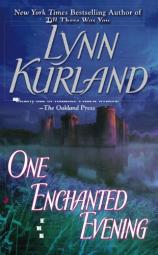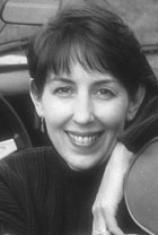Interview: May 21, 2010
Lynn Kurland’s most recent historical romance, ONE ENCHANTED EVENING, is the latest installment in her bestselling di Piaget series, and follows two star-crossed lovers born centuries apart who must endure numerous obstacles --- including a little time travel --- to reach their “happily ever after.” In this interview with Bookreporter.com’s Hillary Wagy, Kurland explains how she pieced together the book’s multi-layered plot, and describes what she personally looks for in romantic heroes and heroines. She also speculates on the appeal of this ever-popular genre, shares what she learned about herself and her work while visiting different periods in history, and reflects on the “magic” found in her own day-to-day life.
Bookreporter.com: ONE ENCHANTED EVENING seems to take the story of Cinderella and her sisters and update it to include loving sisters in addition to an evil sister. CINDERELLA is one of history’s most beloved fairy tales for little girls. Did you draw upon this well-known story as the starting point for the book?
Lynn Kurland: Actually, it was just one of those happy things picked up along the journey. I started ONE ENCHANTED EVENING from the perspective of the hero, Montgomery de Piaget, who had in his youth believed in fairies, thanks to a few paranormal happenings he couldn’t explain any other way. My next thought was, “Wouldn’t it be interesting if the heroine, Pippa, had come to England to host a little girl’s fairy-themed birthday party and a much older, much more jaded Montgomery finally gets to meet --- thanks to a little time traveling at just the right moment --- a real “live” fairy at the very moment when he would least believe that was what she was?” It happened, as these things seem to, that the journey was full of bumps, and one of those was that Pippa had a beauty-queen older sister named Cinderella. It got me to thinking that it would be just Pippa’s luck for Cindi to come along for the time-travel ride and get the guy. It was at that point I thought that a little twisting of Cinderella the fairy tale might make a good extra layer for the already star-crossed lovers.
BRC: Stephen de Piaget asks Pippa, “What inspired you to create your designs?” Pippa replies, “I’d say magic…” Do you believe there is magic in your writing? Is magic one of the tools you use to engage readers?
LK: Personally, I get a little nervous when there are too many supernatural happenings in my own life, so if I use the word “magic,” it’s in a purely speculative sense. I do think, however, that life is full of all sorts of wonderful, serendipitous, cosmic happenings that are unable to be explained away by mere coincidence. And since I think falling in love is one of those magical things, I suppose you can definitely sign me up for it.
BRC: Montgomery de Piaget, our hero, does not believe in magic, yet he and all of the characters in the book accept the fairy tale about a gateway between the past and the future with relevant normalcy, and many familial characters time travel back and forth with ease. Where did you get this idea, and how did you keep all of the concurrent storylines straight?
LK: I keep storylines straight by buying Post-it notes in bulk. I have them everywhere --- on an enormous bulletin board in my office, stuck to covers of notebooks, plastered on cabinets and bookcase shelves. I always reread pertinent older stories while I’m writing a newer book to make sure I’m not missing things (and put the details on --- you guessed it --- Post-it notes!)
As far as the mechanics of time travel go, I had originally decided that my characters were just too prosaic for anything monumental like standing stones or big rents in the fabric of time, so a bench in Gramercy Park or a fairy ring in the grass would have to do. Fairy rings were added to by simple hot-spots in the grass, which were documented by big Xs on a treasure-like map kept by one of the most prolific time-travelers in Scotland (James MacLeod from A DANCE THROUGH TIME). By the time Montgomery is a young adult, he has two aunts and an uncle who are from the present day, so while he doesn’t like to think about it too much, he’s not too surprised by things popping through “gates” he can’t see.
BRC: I liked the inclusion of one-a-day “knightly virtues” that Montgomery’s father taught him. They solidified the romantic nature of the novel. Do you have a cadre of romantic themes/plots you try to include in each of your novels?
LK: I do have certain themes I find important, but I try to, as PRIDE AND PREJUDICE’s Mr. Collins would say, “give them as unstudied an air as possible.” I think there’s something incredibly attractive about a man who is full of chivalry. I like my heroes to always have those “knightly virtues” as part of their code of conduct, no matter how far they might have temporarily strayed from them. I like spunky, courageous, blunt-speaking heroines simply because that’s what I’d like to be when I grow up!
BRC: I noticed you achieved a remarkable romantic relationship with the use of words and actions as opposed to sexy bedroom scenes. When Montgomery says to Pippa, “You decide what your perfect day might contain and I’ll do my best to fit it all into this afternoon.” This one sentence conveys a love that is enduring. How do you feel about the use of bedroom scenes versus the use of romantic language to build your lovers’ relationships?
LK: I don't really think it's a question of “versus” for me. I’m just a big fan of 1950s musicals and comedies where less was definitely more, so that seems to spill over into my writing.
BRC: I loved the way you showed a modern woman that the qualities of a medieval knight and the simple pleasures such as walking along the castle’s shores or riding horseback together on the castle’s grounds could be more enticing than the luxuries of 21st-century life. What was in the betrothal package Pippa brought to Montgomery?
LK: Chocolate. Lots of chocolate!
BRC: You showed the reader that even 800 years of history cannot keep lovers who are meant to live happily ever after apart. Define romance, and why do you think it is such a popular genre in the 21st century?
LK: It would perhaps be easier to blame a love of romance on Disney and too many viewings of Cinderella and Sleeping Beauty during our youth, but I think at the end of the day, there’s simply something magical about falling in love. Home, family, gathering in the evenings in a circle of people you love…there’s nothing like it and it all starts from that moment when two people look into each other’s eyes and realize that nothing is ever going to be the same again.
BRC: There seems to be a flood of paranormal romance novels on the market in the past few years. Why are more authors such as yourself focusing their plots around this phenomena? What is it about our past that feeds our need to know more about our futures?
LK: For me, in my first book STARDUST OF YESTERDAY, the paranormal element was nothing more than wondering how it would be to inherit a castle in England yet find it inhabited by a grumbly yet very sexy medieval ghost --- a ghost the heroine would subsequently fall in love with. It wasn’t so much an interest in paranormal elements, per se, as it was the chance to get a firsthand look at history. For me the time traveling and ghosts who have watched the centuries unfold is just a way to have a front-row seat for history I’d love to see for myself. As far as the popularity of the paranormal genre as a whole goes, I think when you can couple a great romance with a good bit of a fantasy, you have a winner.
Without waxing too philosophical, I will say that I believe there’s something about a grounding in the past that gives us a compass with which to navigate the future. A sense of tradition, and family, and a history that pertains uniquely to us and our progenitors gives us an added sense of purpose and belonging to something bigger than we are. It’s the great human drama full of love and family and adventure.
Sort of like a good romance, actually!
BRC: In your opinion, as a successful New York Times bestselling author, what is the allure of romantic fairy tales?
LK: I think part of it is that they allow us to imagine ourselves in a world where things are much simpler: good is good, evil is evil, and in the end, good wins. We get to try on other personas and see if there might be characteristics there that we might like to take for our own. But I think in the end, it’s mostly because we get the guy who treats us like a princess!
BRC: As a writer, what is the process for achieving “happily ever after” beyond bringing the hero and heroine together? What thought processes and outlines do you use to create the story?
LK: My stories are character-driven, which requires a leap of faith initially where the plot is concerned. I figure out who the main characters are, I know where the story starts, and I have a vague idea of where it ends, then I just sit back and let the movie play out in my head. I’m a fairly visual person, so I spend a lot of time staring out the window, watching the book unfold unimpeded, and basically scribbling down as quickly as possible what I’ve seen. Once the story is down on paper, though, the long knives come out and I start carving until the story on the page begins to resemble what I saw in my head. I only do an outline after the first draft to see where I’ve left loose ends or where the plot has gone awry.
BRC: What have you learned about yourself and your writing by dabbling in glimpses of the past and glimpses of the future? Is there a happy ending in your life?
LK: That I was born in the right time when it comes to a wee laptop I can stick in my purse and write on during breaks as I’m playing chauffeur for the kids, and my iPod full of jazz and classical music, and chocolate in all its varieties, but that I could have definitely enjoyed life at a simpler pace where I spent my time spinning, weaving, and writing things out longhand while watching the seasons change outside. I think I’ve learned to sift what’s important from what’s not through watching my characters leave behind the comforts of their own time period to forge a life in another. It’s made me appreciate my own sweet husband and children so much!
BRC: I loved ONE ENCHANTED EVENING. I felt transported to a different time and place where romance reigned and lovers lived happily ever after. Thank you for the adventure. What can we expect from your next novel?
LK: Thank you for the very kind words!
I’m currently working on the second book of a fantasy trilogy, SPELLWEAVER, due out in January 2011, then I’ll be turning back to some of the secondary characters from ONE ENCHANTED EVENING to watch them find their own happily ever afters!
• Click here now to buy this book from Amazon.
© Copyright 1996-2011, Bookreporter.com. All rights reserved.




